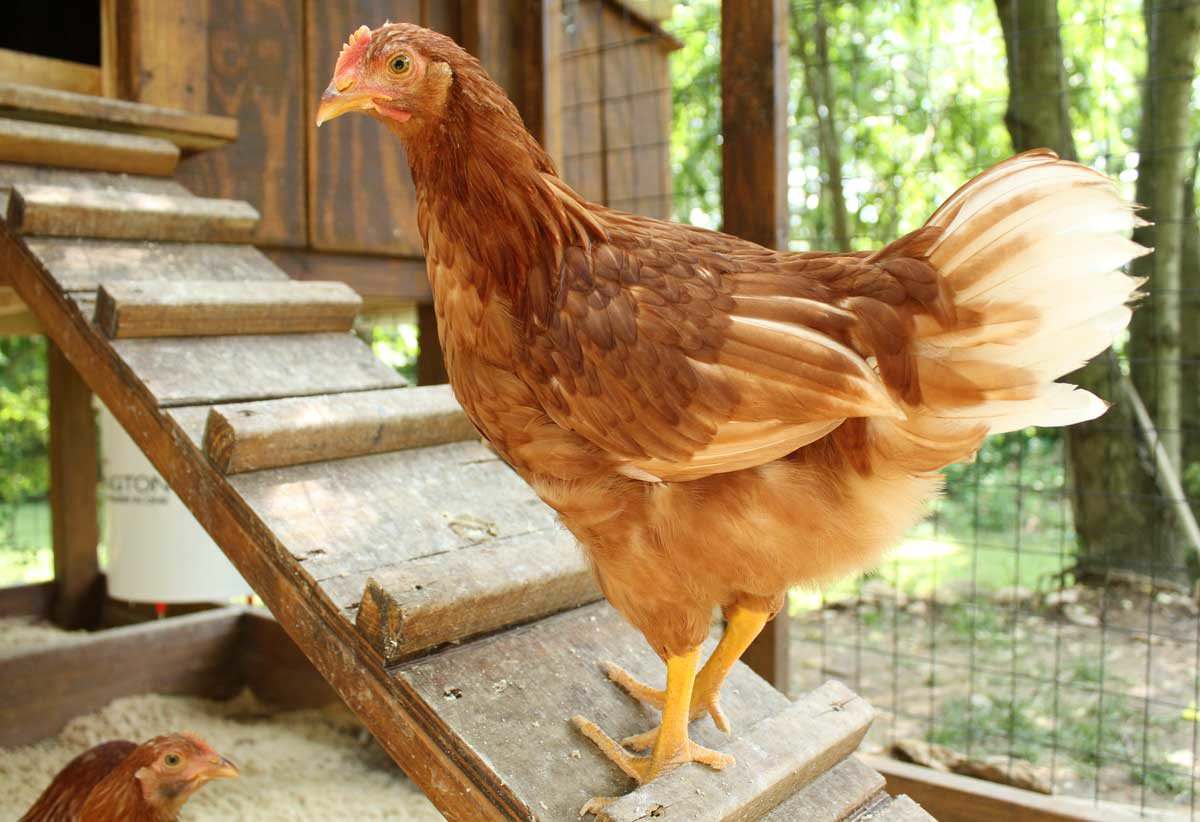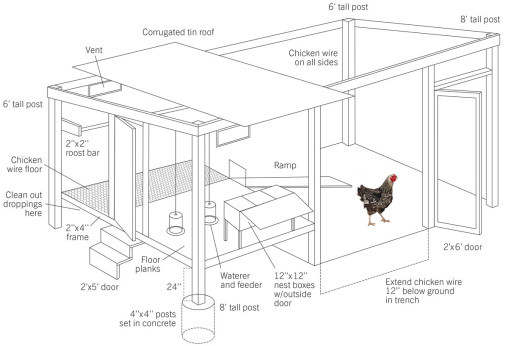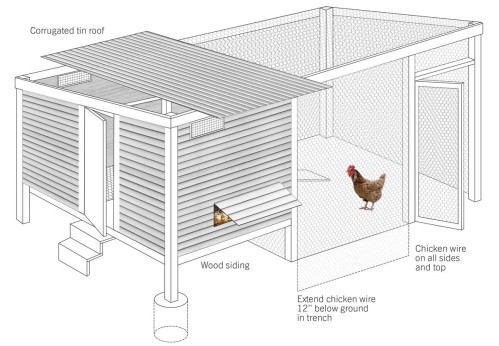Planning to join the masses of backyard poultry farmers this year? Here's what you need to know for a top-notch henhouse.

Building a basic chicken coop for a small flock of birds is a solid weekend project for the determined do-it-yourselfer with basic carpentry skills, while the more elaborate coops could easily take several weeks (and will require advanced carpentry skills).
The internet is awash in plans for backyard chicken coops, which are a great place to look for inspiration, but all coops have two main components: an enclosed space for sleeping and laying eggs and an open air ‘chicken run’ to roam around in during the day. The enclosed space should open directly to the run, but should be elevated at least two feet above it so there is space to collect the droppings that fall through the floor. (More on that in a moment.) There are many possible ways to configure a coop, but here’s how to build a basic model that can easily be customized according to your aesthetic tastes.
[mf_h2 align=”left” transform=”uppercase”]Step 1: Plan for Size and Location[/mf_h2]
The first thing to consider is size. The accepted minimum sizes are 2 to 3 square feet per bird inside the coop and 4 to 5 square feet per bird in the run. However, extra space is always better – just like humans, chickens are prone to squabbling when they’re packed in tight quarters at all times.
Chickens need shade in the heat of the day, so locating the coop under a large deciduous tree is ideal – they will be cool in summer and can bask in the sun during winter once the leaves have dropped. If a site under a large tree is not available, you’ll have to shade the run with shade cloth.
[mf_h2 align=”left” transform=”uppercase”]Step 2: Build the Frame[/mf_h2]
As with most outbuildings, the simplest approach is to begin with a rectangular frame and then add on the various components that are needed. Use naturally rot-resistant lumber – such as cedar or redwood – rather than pressure treated lumber which contains heavy metals, like arsenic, that may be harmful to your chicken’s health. The open-air run should be covered with chicken wire (metal mesh) on all sides to prevent predators from entering.
- Set four 4Á—4 vertical posts in concrete in a rectangular shape based on the size of the coop you need (4 feet by 8 feet or 6 feet by 12 feet or 8 by 16 feet, for example). Cut the posts so the front ones are 8 feet tall and the back ones are 6 feet tall in preparation for installing a pitched roof over the enclosed portion.
- Add a 4Á—4 post 2 feet from the right front corner of the rectangle. This post is to support a gate that will serve as an entryway to the run and should be 8 feet in height.
- Nail or screw a 2Á—4 in a horizontal position between the aforementioned posts on the right front corner of the run at a height of 6 feet.
- Build a gate frame to fit the space of the entryway (a 2- by 6-foot rectangle) using 2Á—2 lumber. This needs to be nothing more than a rectangle of 2Á—2s screwed or nailed together. Use an anti-sag gate kit to prevent the 2Á—2 frame from sagging. Attach the gate frame to the corner post with galvanized gate hinges.
- Add a pair of parallel 4Á—4 posts approximately one-third of the distance from the left side of the rectangle. (For example, if the coop was 12 feet wide, these posts would be 4 feet from the posts on the left side corner posts.) These posts are to support the frame of the enclosed portion of the coop. They should correspond to the height of the other front and rear posts.
- Attach a frame of horizontal 2Á—4s between the tops of all the posts along the front and back sides of the structure, and add three more at an angle between the three pairs of taller front posts and the shorter rear posts as rafters.
- Attach a frame of horizontal 2Á—4s to the four posts on the left side of the rectangle 24 inches above ground level. These will support the floor of the enclosed area.
- Add floor planks on top of the 2Á—4 frame across the front two-thirds of the structure, attaching them with galvanized nails or decking screws.
- Cover the back one-third of the floor with chicken wire. The chickens will be roosting above this part of the floor and the hardware cloth will allow the droppings to fall through so they can be collected from below.
- Dig a 12-inch trench around the perimeter of the run.
- Stretch chicken wire between the posts for the run area on the right two-thirds of the rectangle, vertically between the posts (as walls) and horizontally (as a ceiling), using poultry staples to attach it to the wooden frame. Install the chicken wire so it goes to the bottom of the trenches for protection against digging animals and re-fill the trenches with soil to hold it in place. Cover the gate frame with chicken wire, as well. Wear gloves while working with the chicken wire because the edges are sharp.
[mf_h2 align=”left” transform=”uppercase”]Step 3: Outfit the Interior[/mf_h2]
The interior of the run needs nothing more than a thick layer of straw over the ground to absorb chicken droppings and moisture when it rains. A watering device may also be hung from one of the rafters (by bailing wire attached to a nail) so the birds can drink when they’re outside during the day. (The base of the waterer should be 6 to 8 inches above ground level.) If the run does not receive shade during the hottest hours of the day, add a layer of shade cloth on top of the chicken wire ceiling. Build a gently sloping ramp at least 8 inches wide from the ground level up to the platform for the enclosed area. Before this area is enclosed, outfit it with the following items:
- A roosting bar made with 2Á—2 lumber along the back wall over the chicken wire floor (at least 8 inches in length per bird)
- Nest boxes (at least one 12 inch square box for every 4 birds)
- A watering device and a feeder (hang them 6 to 8 inches above the floor of the coop with bailing wire attached to nails that are pounded into one the roof rafters)
- An incandescent bulb to extend the laying season (optional)
Locate the nest boxes along the front wall at least 24 inches above the floor. These can be as simple as wooden shelves with plywood dividers that are filled with straw. Add a 2-inch piece of wood across the front of the boxes to keep the straw from spilling out. There are also prefabricated nest boxes available, though some chicken keepers use plastic kitty litter boxes for nests because they are easy to remove and clean periodically. The roosts should be positioned higher than the nests. Chickens are descended from tree-dwelling jungle fowl and will always seek out the highest point to sleep (and the nests will quickly become soiled if the chickens use them for roosting).
[mf_h2 align=”left” transform=”uppercase”]Step 4: Finish the Exterior[/mf_h2]
Now is the time to add a roof and walls to enclose the nesting and roosting area. Any weatherproof material may be used, but tin is an easy, yet fashionable, choice for the roof, and wood siding makes a quaint exterior for the walls. (Additional 2Á—4 framing will be necessary for the walls and roof structure.) When you build the walls, make sure to plan for easy access to collect eggs and clean the coop. All access points should be lockable with raccoon-proof latches – a typical gate latch with a carabiner in the turnbuckle is usually sufficient to foil these masked bandits.
Plan for access on three sides:
- A 12Á—12 inch door where the ramp comes in from the run.
- 12Á—12 inch hatches along the front wall to access the nests for egg collection.
- A 2Á—5 foot door on the left wall to access the water and feeder and for cleaning out the coop.
The three types of access doors may be constructed with a simple 2Á—2 frame in the same fashion as the main entry gate to the chicken run. Instead of covering them with chicken wire, use the same material that was used for the exterior of the coop. (No anti-sag kit will be needed in this case.)
Ventilation is extremely important in summer. The chicken door and the portion of the floor covered with wire mesh will allow air in from below, but there are also needs to be a place for hot air to exit at the top. Either leave space between the eaves of the roof and the top of the walls or cut vents near the top of the walls. In either case, makes sure these spaces are covered with chicken wire to keep critters out.
These are the basics of a functional coop, but feel free to customize it and glorify it any way you like. Ornate trimwork, gaudy knick-knacks, and colorful artwork are all par for the course in the world chicken coop décor.


Can I get the plans?
Very helpful info. Am staring this weekend.
Can I get a printout of these plans ? Thank You
Hi,
I’m a little concerned about the corrugated roof. I have worked in a corrugated shed and when it rained the noise was deafening, also there is likely to be condensation on the inside and it provides zero hat insulation.
My hen huts have ply roof with felt.
Cheers
Michael
There are many advantages to owning your own chickens. Farm fresh eggs are healthier, tastier, and readily available from your own back yard. Meat birds are fast growing, take little space to raise and are fairly inexpensive for the resulting outcome in food production. Raising your own chickens means you get to decide what goes into the making of the final product. I personally build a great chicken coop following this easy and step by step guide I found HERE: ( http://easy-chicken-coop.trusted-source.info )
Send plans
Thanks for the information.
it will be very helpful
Is it possible to get a copy of the plans?
I find this information very useful, am planning to start poultry farm in at home.
Thanks for your support.
Samuel
Uganda Kampala
it really looks amazing and inspiring, the structures. I like it to build for my chicken very helpful. think you
miles kennedy macloudy
zambia